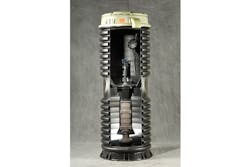For most homeowners, the nation’s crumbling wastewater infrastructure is out of sight and out of mind until floods send unhealthy street runoff and sewage through their basements’ cracks and plumbing fixtures, often stopping the devices in place for protection. A storm of historic proportions, such as a 100-year flood, is no longer required to wreak havoc on a wastewater network, the same network that the U.S. Environmental Protection Agency estimates will cost $82.6 billion for new pipes and pipe repair.
As Chicago’s Basement Flooding Partnership noted, "There is a new kind of storm hitting in recent years — heavy rains that can be very local, very intense and hard to predict. They dump two inches or more per hour on a given neighborhood. The volume quickly overwhelms local sewers, which were not designed for such intense rainfall. Sewer mains fill up and additional water pushes into basements through our private drains. When sewers are full, the water has nowhere to go but your basement."
West Virginia case study
Homeowners may consider their first basement flood bad luck. When it happens five times in a few years, as one Martinsburg, West Virginia, resident experienced, myriad causes are possible. After his fifth basement flood, he sued the local sewer district. His basement’s plumbing fixtures were the relief point rather than an outside cleanout or manhole, since they provided the lowest escape location for the combined water and sewer lines.
Martinsburg prescribed an increasingly common remedy, a grinder pump. The basement has not flooded again. The grinder pump is now considered an innovative stormwater control device preferred by some instead of sump pumps, flap gate valves or floor drain plugs.
Product of choice for many water companies
Local government programs in several states subsidize the pumps’ cost and installation. In the nation’s capital, D.C. Water has sought legislation reading, "For new construction or where renovation costs exceed 50 percent of the assessed value, require grinder pump or sewage ejector system with battery backup if lowest floor elevation is lower than manhole rim."
Roughly the size of a dishwasher, a grinder pump station can collect all of a home’s wastewater. Usually installed outside the house, the unit’s tank collects effluent until it reaches a certain level. The 1-horsepower pump turns on automatically, grinds wastewater into fine slurry and transports it under pressure through a small-diameter, infiltration-free pipe to the sewer main.
In many regions — such as the East Coast, Great Lakes and parts of the Midwest — municipalities rely on combined stormwater and sewage systems, and their open joints and/or cracks leave them vulnerable to groundwater infiltration. Chicago’s combined system is notorious for this problem, and the residents of Everett, Washington, (which offers a grinder pump program) call its water infrastructure antiquated.
Except for areas serviced by low-pressure sewer systems (LPS), most wastewater conduits in the country rely on gravity, a method dating back to the Roman era.
"Gravity sewer systems are the oldest, most common type of sewers," says Rick Higgins, director of operations of the Duckett Creek Sanitary District outside St. Louis, Missouri. "Grinder pumps — as the name implies — do not rely on gravity. By switching from a gravity sewer to a [grinder] pump [low-pressure] system, water can no longer flow by gravity into your house."
More than 16,000 grinder pumps are used by South East Water in the tourist area of Mornington Peninsula, Australia. Using the pump’s spare tank capacity, the inflow and infiltration-free system is also configured as an intelligent sewer network controlled by telemetry from a smartphone or tablet.
Advantage comparison
Recent basement plumbing systems often incorporate grinder pumps. Their advantages are viewed through a different prism, especially when compared to alternatives:
- Cleanout (floor drain) plugs — This technology only works if someone inserts the plugs before the water level rises. They are often ineffective because intensified pressure can pop the plugs like Champagne corks and drain holes, becoming geysers. They cannot drain a basement until the pressure subsides. If not capped, sewage gas or sewage can continue to back up into a basement.
- Check (flap gate) valves — These can blow or be propped open by small bits of solid waste, such as toilet paper.
- Sump pumps — They stop operating during power outages. They may be incorrectly installed or insufficiently sized. Sometimes two are needed and their only fluid storage is in their pipes.
Higgins says some neighboring water districts offer to install valve systems for basement flood victims, but they may be unreliable. "After a big flood event, I was explaining the grinder pump and other options to one of my customers. [I] told her about the valve system that [one water district offers]. That night the homeowner saw [a] customer [from this district] on the 5 o’clock news explaining how he had just gotten one of these valves and [got] flooded anyway."
Steve Greenberg, vice president of KLH Engineers, says the group resolved basement flooding with grinder pumps in about 20 homes in Shaler Township, Pennsylvania.
"They put backup preventers in, and we came up with … grinder pumps," Greenberg shares. "That was close to 20 years ago, and all are still working beautifully."
Conclusion
Grinder pumps may not provide relief in Superstorm Sandy-type events, when houses’ basements and first floors were under water. However, as water districts struggle to keep up with basic repairs and finance upgrades, the use of grinder pumps in flood-prone areas is one option for basement protection.
Joseph Harmes is a freelance writer who has documented the evolution and acceptance of grinder pumps and low-pressure sewer systems. For more information, visit eone.com.
